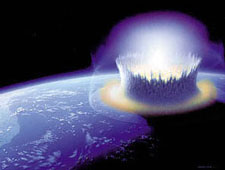
Sixty-five million years ago the cataclysmic impact of a gigantic meteor disrupted the world's climate and wiped out most flora and fauna on Earth, including the dinosaurs. This painting by Don Davis depicts the scene a few seconds after the body struck just north of what is now Mexico's Yucatán peninsula. Within hours a cloud of dust enveloped the globe, and huge tsunamis surged hundreds of miles inland.
The fabulous Leonid meteor storms have produced some of the most spectacular astronomical sights in history. These blizzards of light struck terror in people's hearts as the sky appeared to be falling. At other times, the glare of a bright bolide — perhaps followed by a tremendous explosion — can provoke anything from momentary surprise to vast destruction.
Most meteoroids from space burn up as meteors — streaks of light — in the upper atmosphere. Only rarely do meteorites survive the plunge to reach the ground. When they do, they become objects that pass from the heavens to Earth. As such, they have left a bigger imprint on human history than is generally realized.
The Iron Age
One characteristic that separates humans from animals is that we make lots of tools. Our early ancestors fashioned their first tools from bone, wood, and stone. The Stone Age takes its name from when stone implements represented the highest technology available. Later, copper and its alloy with tin (bronze) were discovered, yielding more durable weapons and tools that offered significant advantages to their possessors. The Bronze Age started during the third millennium B.C. for much of Eurasia, though its beginning and end varied widely around the world. Then around 1400 B.C. the Hittites of Asia Minor discovered that iron could be smelted from common ores to produce even more superior tools and armory, thus giving birth to the Iron Age.
But how was iron discovered? Copper's melting point (1,980° Fahrenheit) is low enough that simple fires can both reveal and smelt the ore, while iron's melting point (2,795°F) requires intentional discovery and special methods for processing. What gave the clue that iron should be sought and developed?

This gold-inlaid knife from the reign of Emperor Jahangir, the fourth Mughal ruler of India, was forged from an iron meteorite that fell on April 10, 1621. Jahangir ordered that two swords, a dagger, and a knife be made from the meteorite, which was believed to possess magical powers. Only the knife is still known to exist. An iron dagger of meteoritic origin was also discovered in the tomb of the 14th-century B.C. Egyptian pharaoh Tutankhamen in 1922.
Courtesy Freer Gallery of Art/Smithsonian Institution, Washington, D.C.
Many late Bronze Age archaeological sites actually contain artifacts made of approximately 90 percent iron. A famous example is the dagger recovered from the tomb of the 14th-century B.C. Egyptian pharaoh Tutankhamen. Chemical analyses show the dagger's "impurities" to be largely nickel, a sure sign that the iron came from a meteorite. So early metalsmiths found and used naturally smelted iron. They would have quickly realized its superiority. The Hittites and Sumerians acknowledged this connection by calling iron "fire from heaven." The Egyptian word for it means "thunderbolt of heaven," and the Assyrian term was "metal of heaven." With meteorites as an inspiration and a direct guide, the recognition of Earthly iron ores was probably inevitable. Meteorites jump-started the Iron Age.
When European explorers encountered a tribe of Inuits in northwestern Greenland in 1818, they were astounded to find knife blades, harpoon points, and engraving tools made of meteoric iron. Tools from the fabled Greenland meteorite had been found as far as 1,400 miles away, having been transported as treasured trade goods. The area has no natural metal deposits, yet the abundant availability of meteoric iron allowed the polar hunters to skip to the Iron Age and helped them survive in an extremely harsh land.
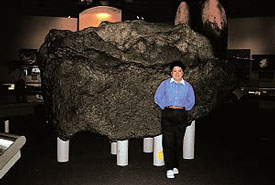
The 'Ahnighito' or Tent meteorite from Greenland on display at the American Museum of Natural History in New York City. The largest of the three Cape York meteorites recovered by Robert Peary in the late 1890s, this 34-ton hunk of iron and nickel measures 11 feet long, 7 feet high, and 5-1/2 feet thick.
Courtesy Edwin L. Aguirre with permission of the American Museum of Natural History.
Five expeditions from 1818 to 1883 failed to find the "Iron Mountain" until Robert E. Peary was led by a local guide to the site on Saviksoah Island off northern Greenland's Cape York in 1894. The meteorite was found in three primary masses, named the Tent or "Ahnighito" (34 tons), the Woman (2½ tons), and the Dog (½ ton). Over the next three years Peary's expeditions managed to load them onto ships despite savage weather, engineering problems, and having to build Greenland's only railway for transporting the behemoths. Upon arrival in New York City, the source of Greenland's Iron Age were sold to the American Museum of Natural History for $40,000, where they are now on display at the Hayden Planetarium.
Ironically, even today, 27 percent of the world's nickel comes from mines in the large Sudbury meteor crater in Ontario, Canada.
Sacred Stones
In 205 B.C., Hannibal's Carthaginian armies had marauded Italy for more than a dozen years, threatening the very existence of the Roman republic. After witnessing a frightening meteor shower, the Roman magistrates consulted the Sibylline books, which prophesied that Hannibal could be defeated if the Idaean Mother was brought to Rome. This "Mother," a large, conical meteorite thought to represent the Great Mother of Gods, was enshrined in a temple at Pessinus in central Turkey. The resplendent Roman delegation that was sent to King Attalus gained permission to remove the meteorite only after an earthquake changed the monarch's mind. A sacred ship was built and the meteorite sailed up the Tiber River to Rome. The leading citizen in the city performed the rituals of hospitality for the rock, then a procession carried it to the Temple of Victory. With this divine morale boost, the Romans expelled Hannibal from Italy within the year and soon conquered Carthage.
In gratitude, the Romans built a special temple on the Palatine hill where the meteorite was worshipped for at least 500 years. However, the stone eventually fell into oblivion. In A.D. 1730 it was apparently excavated from its chapel, only to be discarded for lack of recognition.
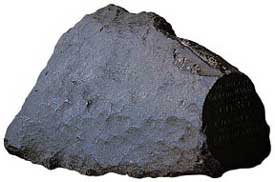
The 1,635-pound Red River iron meteorite from central Texas currently resides at Yale University in New Haven, Connecticut. Considered sacred by the Pawnee Indians, the rock was donated to Yale by the wife of George Gibbs after his death in 1833.
Courtesy Martha Schaefer.
Many meteorites have been worshipped as gods through the ages. One such sacred rock was uncovered in 1808, when a party of explorers found a 1,635-pound hunk of metal near the Red River in central Texas. The Pawnee Indians had worshipped this meteorite for its curing powers and made regular pilgrimages to its site. The explorers, who thought the metal was platinum, returned to the city to get provisions and equipment. They eventually split into two rival groups as they tried to outrace one another in cashing in on the treasure. The first party, which had left hastily without the gear for transporting the hefty load, could only hide the "platinum" under a flat stone for safekeeping while they searched for horses.
It took several days for the second party to find the prize and drag it toward the Red River. In their long overland journey they were repeatedly attacked by the desperate Indians. The meteorite was transported by boat down the river to New Orleans, and finally to New York. There, Benjamin Silliman of Yale University recognized its true nature based on its high nickel content, after which the disappointed owners sold the object to Colonel George Gibbs. After Gibbs' death in 1833 his wife rescued the meteorite from Irish laborers seeking to bury it; she then donated the rock to Yale as the largest meteorite in any collection at the time.
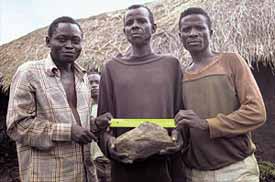
On the afternoon of August 14, 1992, a shower of stony meteorites pelted Mbale, Uganda, and its surroundings. These men from neighboring Malukhu recovered a fragment that weighs 24 pounds and created a crater 3½ inches deep. The villagers believed that the stones were endowed with medicinal powers to cure illnesses, including AIDS.
Courtesy the Dutch Meteor Society.
In 1853 a meteorite that fell in eastern Africa just north of Zanzibar was declared to be a god by the Wanika tribe until famine and a massacre by the Masai rendered its owners skeptical of its powers. On December 2, 1880, a 6-pound meteorite fell at the feet of two Brahmins near Andhra, India, who immediately proclaimed themselves as ministers of the "Miraculous God" and attracted up to 10,000 pilgrims a day. On August 14, 1992, dozens of rocks fell on the African town of Mbale in Uganda (Sky & Telescope: June 1993, page 96). Local residents ground up some of the fragments and ingested the powder as medicine. They believed the rocks had been sent by their god to cure AIDS.
It's easy to understand that a fiery descent from heaven can be interpreted as a god, or a god's gift, come to Earth.
The black Stone of Emesa
The slow fall of the Roman empire was a chaotic drama in which a wide variety of religions coexisted and competed, often with the emperor's worship playing a key role. In addition to the traditional Roman pantheon, gods with Greek, Hebrew, and Egyptian origins enjoyed widespread followings.
In this marathon of competing faiths a steady front-runner was the Sun god, variously called Apollo, Helios, Sol, Sol Invictus, or Elagabalus. The overwhelming power and importance of our day star makes a Sun god a natural chief deity; its worship is deeply embedded in many societies. The cult of the Syrian Sun god Elagabalus was known in Rome from before the time of Julius Caesar, but it only came to dominance with the ascension of the Roman emperor Marcus Aurelius Antoninus.
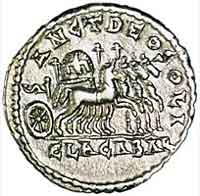
This silver coin was struck in A.D. 218-219 in honor of the young Roman emperor Marcus Aurelius Antoninus, who adopted the name of the Sun god Elagabalus. Antoninus was the high priest of the cult that worshiped the Black Stone of Emesa, which is believed to be a large meteorite. Shown here are four horses pulling the ceremonial chariot that carried the stone (behind the eagle). The emperor led the procession to Rome while walking backward to keep his face toward his god. The inscription SANCT(O) DEO SOLI ELAGABAL(O) means 'To the holy god, the sun Elagabalus.'
Courtesy M.R. Molnar Collection.
As a young boy, this emperor was made the high priest at the magnificent temple in Emesa (now Homs) in Syria, as a hereditary responsibility through his mother's family. He took his religious duties very seriously and even changed his name to that of his god, Elagabalus. The worship of Elagabalus was centered on the Black Stone of Emesa, a large, cone-shaped meteorite. When its high priest moved to Rome the stone came with him. Two magnificent temples were built for it, one on the Palatine hill and the other in the suburbs. The emperor personally led daily worship of the meteorite while dressed in silk robes, a lofty tiara, and cheeks painted red and white. Meteorite worship became the official religion of the Roman empire.
Elagabalus's cruelty, extravagance, neglect, and depravity quickly alienated him from all segments of society, so he was doomed to a short reign. On March 6, 222, at age 18, the emperor and his mother were assassinated by the Praetorian Guards, and their mutilated corpses were dragged through the streets of Rome.
As for the meteorite, it was quietly returned to Syria and reinstalled in the temple of Emesa. The rock was likely broken into pieces when the temple was converted to a Christian church sometime in the 4th century. The site, now a mosque, has never been excavated.
Even after the disastrous reign of Elagabalus, the Sun god remained as the most important deity. Many cities throughout the empire had instituted games in its honor by 240. The emperor Aurelian elevated Sol to the highest rank among all gods in 274, and this practice was followed by all rulers until the time of Constantine, who reigned from 306 to 337. Even Constantine wavered between Sol and Christ, and his coins celebrated the Sun god as the grantor of imperial power as late as 324, after which he converted both himself and his empire to Christianity.
The spread of Christianity throughout Europe occurred for many reasons; still, it is amusing to wonder if it was only by the whim of an emperor that the western world now is predominantly Christian instead of meteorite-worshipping.
The Black Stone of the Kaaba
The most famous sacred meteorite is the Black Stone of the Kaaba. The Kaaba is a cubical building in Mecca toward which Moslems pray five times daily. The Black Stone, set in the northeastern outside corner of the Kaaba, is considered to be the most sacred treasure of Islam.
The Kaaba also served as a center of worship for pre-Islamic Arabs and was reputed to contain 360 idols. In 630 the triumphant prophet Mohammed returned to Mecca and cleansed the temple of the idols after honoring the Black Stone. The heretical Qarmatian sect stole the stone in 930, but it was recovered 21 years later with positive identification provided by the stone's ability to float on water. In 1050 a mad Egyptian caliph sent a man to destroy the relic. The Kaaba was twice burned down and was flooded in 1626. During these trials the original stone was broken up into about 15 pieces. It was finally set in cement surrounded by a silver frame.
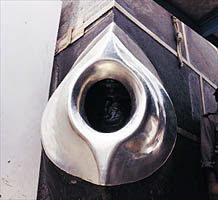
In the middle of Mecca's Grand Mosque is the black, cubic shrine of the Kaaba, the 'House of God,' which was said to have been built by Abraham (Ibrahim). On one corner of the Kaaba is the Black Stone, which is believed to be of meteoric origin. The exposed surface of the stone is roughly 6½ by 8 inches and is framed with a silver band. Here pilgrims can touch and kiss the Black Stone. Some suggest that the object is not really a meteorite but may be impact glass, perhaps from the meteor craters at Wabar, 670 miles east of Mecca.
Courtesy Peter Sanders Photography.
Islamic tradition variously describes the stone as coming from heaven and as originally hyacinth in color before it turned black because of humanity's sins. Reports of its visual appearance mention a dark, reddish black color, smooth surface, some apparent banding, and small crystal inclusions. Although generally regarded as a meteorite, it cannot be an iron-type meteorite since it fractures, nor can it be a stony meteorite since it would not have withstood the handling and would sink in water. Similar arguments may reject nonmeteoritic origins, such as basalt or agate.
In 1980 Elsebeth Thomsen proposed that the Black Stone is an impactite (fused sand mixed with meteoric material) from the Wabar Crater in Saudi Arabia's Empty Quarter (Sky & Telescope: November 1997, page 44). The Wabar impactite is a hard glass (so it is tough enough for repeated fondling yet can shatter) with a porous structure (so it can float) and having inclusions of white glass (the crystals) and sandstone (the banding). The change from its original lighter color could be due to the accumulated oils from frequent kissing and handling. A critical problem confronting this proposal is that several measurements suggest the Wabar Crater is only a few centuries old, though other analyses suggest it was formed 6,400 years ± 2,500 years ago. Whether or not Wabar is the source, the Black Stone still fits well with a desert impactite and a meteor tradition.
The End of the Dinosaurs
What ended the age of dinosaurs 65 million years ago? Until 1980, paleontologists would answer their biggest mystery by mumbling something about climate, mammals, or volcanoes. Then Luis Alvarez and his coworkers hypothesized that a giant meteorite hit the Earth and caused global environmental damage, leading to the reptiles' extinction. Alvarez and his team tested their idea by seeking the element iridium in sediments around the world laid down at the correct time. Iridium is often abundant in meteorites but rare from Earthly sources. Alvarez examined clay from the distinct K-T boundary (named after the Cretaceous-Tertiary geological epochs) at three widely separated sites. They indeed found a thin layer of iridium-rich sediment coinciding with the death of the dinosaurs.
The startling discovery of iridium at a few sites was intriguing, but the scientific community wasn't won over to the new idea. Various groups rushed to check many sites widely spread around the globe and confirmed that there really is an iridium layer and it really is worldwide. Then, the groups searched for and found other evidence, such as the presence of the element osmium and right-handed amino acids, which are relatively abundant in meteorites but rare on Earth. As the excitement mounted, yet more researchers found microtektites in the K-T boundary layer.
But most geologists withheld judgment until the unique signature of shocked quartz was also found to be widespread and sharply confined to the K-T boundary. Finally the 110-mile-diameter Chicxulub crater was discovered under Mexico's Yucatán Peninsula. Its age of 64.98 million years ± 60,000 years matches that of the K-T boundary (64.3 million years ± 1.2 million years).
This progression from intriguing proposal to certainty of a gigantic meteor impact of worldwide consequences was made in only a few years and is a classic example of the repeated tests of critical predictions that is the hallmark of the scientific method. The research and debate has now shifted to understanding the consequences of the Chicxulub event. The immediate shock and heat from the impact would annihilate all life within perhaps a 1,000-mile radius from ground zero, while tsunamis would devastate anything near sea level in the Atlantic basin. Indeed, layers of tsunami-wave rubble have been found more than 30 feet thick all around the Caribbean, and the deposits extend up to 430 miles inland.
The initial blast would also send out large masses of ejecta, which would reenter the Earth's atmosphere over the entire globe; the combined heat from all these simultaneous secondary meteors lighting up the sky would kindle worldwide forest fires. Indeed, the volume of soot in the K-T layer indicates that the majority of the world's biomass was burned to a crisp. In the months and years that followed, a dust veil would have cut off most sunlight, stopping photosynthesis and creating a "meteor winter." Together with other forced and deadly effects, entire food chains collapsed. The dinosaurs, unable to adapt, died out. Only about half of the world's species, including mammals, managed to have some breeding population survive through the holocaust.
Here we have a scientific revolution fought and finished in a decade, where the scientific community was won over by the great strength of the evidence, despite various deep prejudices. This is science at its best, and it makes me proud.
Target Earth
NASA's robotic missions to other planets have shown that all old, solid surfaces in the solar system are heavily cratered. Earth too must have been heavily bombarded, but the evidence has been largely hidden by the erosion acting on the surface of our dynamic planet. Even so, the many meteorite finds, Chicxulub, and the approximately 140 known craters around the world demonstrate that Earth has suffered massive hits.
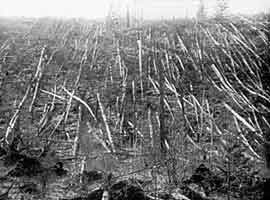
Trees near the Tunguska River in Siberia still looked devastated nearly two decades after a large meteorite exploded four miles above the ground in June 1908. The Tunguska event, which ranks as one of the most violent cosmic impacts of this century, leveled nearly 1,400 square miles of taiga forest.
Courtesy Sovfoto.
In modern times, the best known destructive impact occurred in a remote region of taiga forests near the Tunguska River in eastern Siberia at about 11:30 a.m. on June 30, 1908. The explosive energy released by the event was equivalent to roughly 15 million tons of TNT — a thousand times more powerful than the Hiroshima bomb and matching a large hydrogen bomb. The meteorite, likely of stony composition with a diameter of 200 feet, exploded at an altitude of 5 miles, creating an air burst that leveled more than 1,200 square miles of forest. But this famous event is by no means unique even in the current century.
Early on the morning of August 13, 1930, a large meteorite exploded over the Amazon jungles in an isolated area on the Curuçá River with a force estimated to be a tenth of the Tunguska event. The bolide was heard as a shriek of artillery shells followed by great balls of fire that fell from the sky like thunderbolts. Three massive explosions and three shock waves ripped through the jungle, followed by a very light rain of ash that veiled the Sun until midday. The blasts were heard up to 150 miles away, while the resulting magnitude 7 earthquake was recorded 1,320 miles away in La Paz, Bolivia. This massive meteor explosion would not have been known to the outside world if not for a Capuchin monk, Father Fedele d'Alviano, who had visited the terrified population during his yearly apostolic mission and then written about the event for the papal newspaper.
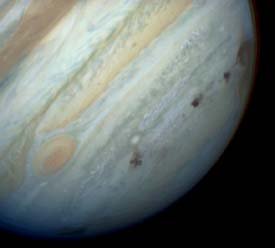
Image of Jupiter with NASA's Hubble Space Telescope's Planetary Camera. Eight impact sites are visible. From left to right are the E/F complex (barely visible on the edge of the planet), the star-shaped H site, the impact sites for tiny N, Q1, small Q2, and R, and on the far right limb the D/G complex. The D/G complex also shows extended haze at the edge of the planet. The smallest features in this image are less than 200 kilometers across.
Courtesy NASA & Hubble Space Telescope Comet Team.
The collision of Comet Shoemaker-Levy 9 with Jupiter in July 1994 was a widely publicized event. Most of the educated population in the world heard about the dark impact scars on the Jovian atmosphere, each larger than Earth. If such a comet were to hit Earth, mass extinction would be the most likely scenario. The moral of the Amazonian, Tunguska, and Shoemaker-Levy 9 events is that such occurrences are not unique even in modern times. Collisions of catastrophic proportions and worldwide scale can happen anytime within our lifetimes.
Over the last decade or so, there has been a big change of consciousness among both scientists and the general public. The paradigm now is the realization that the Earth is a target in a giant shooting gallery, with the stakes as large as civilization itself. Countless articles, books, and movies on the threat of meteorite impacts have already appeared (Sky & Telescope: June 1998, page 26). Thankfully, the larger the explosion, the rarer the event. Metropolis destroyers, with an explosive energy on the order of 100 million tons of TNT, happen roughly once per millennium. Regional destroyers, about 100 billion tons of TNT, have an event rate of around once per hundred millennia. Civilization destroyers, about 100 trillion tons of TNT, average once every 10 million years or so.
Astronomical events have changed history and affected the lives of ordinary people in a surprising number of ways, but only meteorites actually come down to Earth. They have had a great impact on humanity — as a resource for building civilization, as a god come to ground, and as the cause of mass die-offs. But as you are watching the fiery trails of Perseid or Leonid bolides, please remember only the majesty and not the terror.
 0
0
Comments
You must be logged in to post a comment.